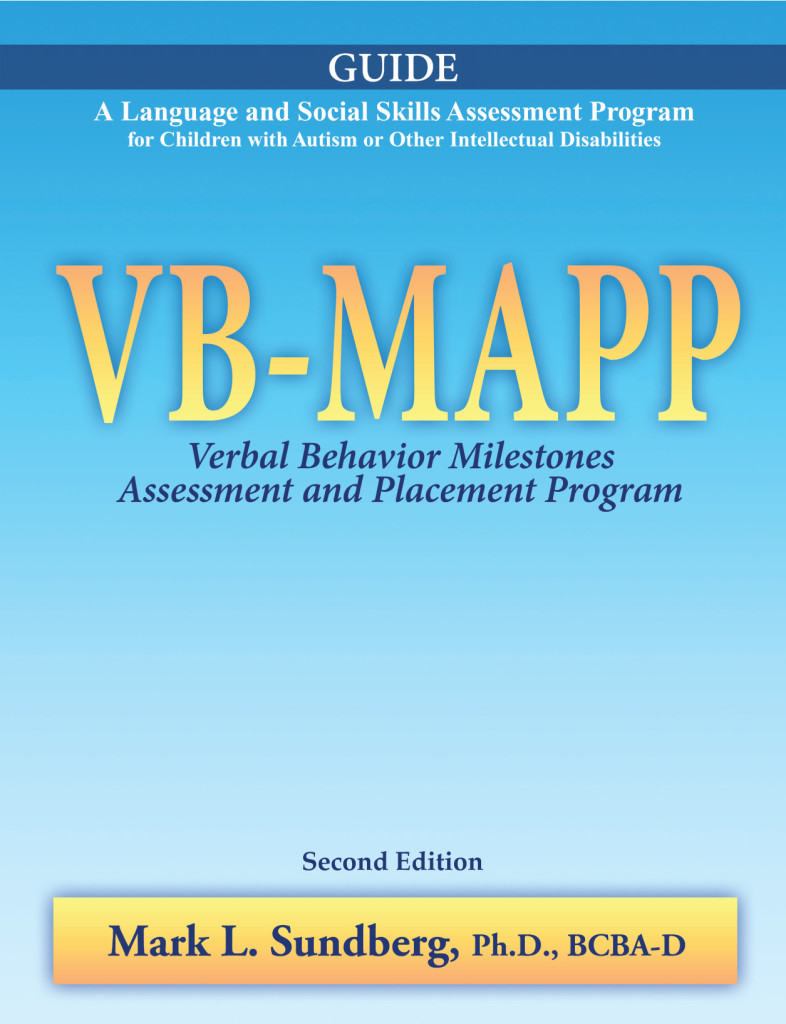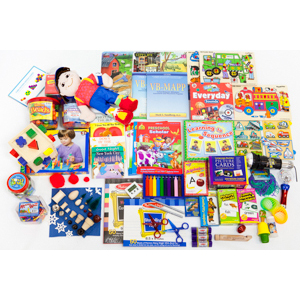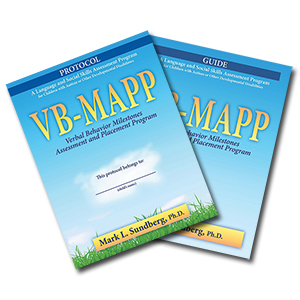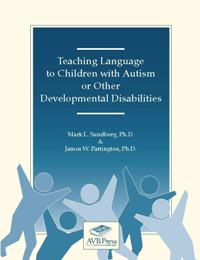Today marks the start of Autism Awareness Month. This year, we’re thrilled to introduce a series of exclusive interviews with renowned experts on topics that are of interest and importance to both parents and professionals working with students on the autism spectrum. We can’t think of a better way to kick off this series than with an information-packed interview with Mark Sundberg, PhD, BCBA on the Essentials of Verbal Behavior.
Dr. Sundberg hardly needs an introduction. He is the author of the VB-MAPP, Teaching Language to Children with Autism and Other Developmental Disabilities, and co-author of the original ABLLS. Additionally, he has published over 50 professional papers and 4 book chapters and taught more than 80 university courses on behavior analysis, verbal behavior, sign language, and child development. He is a licensed psychologist with over 40 years of clinical experience.
We’re honored that Dr. Sundberg agreed to kick off Autism Awareness Month here at Different Roads and answer these questions on Verbal Behavior from BCBA Sam Blanco. A big thank you to Cindy Sundberg as well for her help with the interview.
Essentials of Verbal Behavior
with Mark Sundberg, PhD, BCBA-D
SAM BLANCO: There is often confusion about what differentiates ABA and Verbal Behavior. Can you tell us what Verbal Behavior is and how it relates to ABA?
MARK SUNDBERG: In the 1950s B. F. Skinner published the book Science and Human Behavior (1953). In that book he described how the basic concepts and principles of behavior analysis could be applied to human behavior. This book is credited for starting the field of Applied Behavior Analysis (ABA) (Morris, Smith, & Altus, 2005). A few years later Skinner published the book Verbal Behavior (1957) which contained a detailed analysis of language, a topic he addressed frequently in Science and Human Behavior and other writings. The verbal behavior (VB) approach (or ABA/VB) to autism treatment is based on these two Skinner books, and over 60 years of conceptual and empirical research that has evolved primarily from this original material.
Regarding the similarities and differences between ABA and VB, first they both make use of the same principles, procedures, and research basis of behavior analysis (Skinner, 1953). That is, they both use the basic procedures of prompting, fading, shaping, reinforcing, and so on (cf. Cooper, Heron, & Heward, 2007). The primary difference between the two approaches is the analysis of language that underlies the assessment and intervention programs. The VB approach makes use of Skinner’s (1957) behavioral analysis of language along with ABA principles and procedures, while most ABA and cognitive-based programs use the traditional expressive and receptive framework of language. Although this seems to be changing in that more ABA approaches and outcome studies are incorporating aspects of Skinner’s analysis (e.g., manding) into their intervention programs (e.g., the Sallows & Graupner, 2005 outcome study).
The main advantage of Skinner’s treatment of language for children with autism is that he breaks down expressive language more thoroughly and functionally. He suggests that the “mand,” “tact,” and “intraverbal,” are functionally different from each other because they are controlled by different environmental variables. For example, the mand is under the functional control of motivational variables (what a child wants), while the tact is under the functional control of nonverbal discriminative stimuli (what a child sees, hears, etc., but may not want). It is not uncommon to encounter children with autism who have dozens of words as tacts, but no words as mands (their mands may occur in the form of tantrums or other negative behavior). In the traditional analysis of expressive language this distinction between the mand and the tact is not made, thus a resulting intervention program may not completely or accurately address a child’s needs. These important differences in verbal skills are not typically assessed by most of the common assessment tools used for children with autism (Esch, LaLonde, & Esch, 2010). For more details on the value of incorporating Skinner’s (1957) analysis of verbal behavior into ABA programs, the reader is referred to Petursdottir and Carr (2011) and Sundberg and Michael (2001).
SB: Can you tell us a bit about developing the VB-MAPP? It must have been quite an undertaking!
MS: I’ve been working on applying Skinner’s (1957) analysis of verbal behavior to language assessment and intervention since the 1970s when I was one of Jack Michael’s graduate students at Western Michigan University. This topic became the foundation of my doctoral dissertation (Sundberg, 1980), and has been the main focus of my professional career. The VB-MAPP was designed to be an assessment tool that is comprehensive, precise, developmentally matched, and functionally valuable to the child. As a result, the information obtained from the VB-MAPP can assist in IEP planning and help to establish intervention priorities, and serve as a curriculum guide for the program. The VB-MAPP is also designed to serve as a dependent measure in empirical research, and outcome research. In addition, problem behavior and various other “barriers” impact learning and should be assessed along with language, learning, and social skills. If left unattended, these barriers can slow down a child’s skill acquisition or possibly bring any gains to a complete standstill, and leave the child susceptible to other problems. Thus, the VB-MAPP also contains an assessment of 24 barriers that might affect a child (e.g., escape and avoidance, prompt dependency, demand weakens motivation).
The VB-MAPP has greatly benefited over the years from the many parents and professionals who have provided feedback or conducted field-testing with typical children and children with special needs in schools, homes, clinics, and community settings. This feedback and field-testing provided us with a wealth of information that influenced many aspects of the VB-MAPP, such as checks for generalization throughout the assessment, tips for the tester, more information in the Guide about the skills being assessed, and a placement program to provide general direction for intervention and IEP development. Our own field-testing activities also helped us with many of the improvements, such as the refinement of the sequence and validity of the intraverbal assessment (e.g., Sundberg & Sundberg, 2011), and separating play skills into independent play and social play for a tighter assessment of this area. In addition, there is now a more extensive body of conceptual and empirical research that has advanced our overall understanding of language acquisition and the treatment of autism.
We were also fortunate to have Barbara Esch, Ph.D., CCC-SLP, BCBA-D include her Early Echoic Skills Assessment to the VB-MAPP. Her tool presents a state-of-the-art method to quickly assess a child’s echoic repertoire, and it fits well within the VB-MAPP. The VB-MAPP also contains a short transition assessment that resulted from many years of consulting to special education classrooms and attending IEPs. We thought it would be useful to create a piece of the assessment that could help to determine what type of educational format might best suit an individual child (e.g., 1:1 vs. small group instruction, inclusion). The targeted milestones in the VB-MAPP have been carefully chosen and matched to those of typically developing children, thus providing a clearer picture of how a child with autism is performing. We aligned the VB-MAPP with standardized, and well-respected assessments, including the APES, Bayley-III, PLS-IV, and the Vineland-II. As a result of these various features, the VB-MAPP moves beyond just an assessment of basic skills to a more thorough and functional assessment of the whole child.
The work on the VB-MAPP and making ABA and verbal behavior understandable and accessible continues to be an on-going process. After the VB-MAPP was published in late 2008, we received interest from professionals wanting electronic versions and foreign language translations. The VB-MAPP is now also available as an app and web-based format, as well as in several different languages including Chinese, French, Italian, Polish, Russian, and Spanish, with other languages in various stages of development.
SB: For a learner who is just developing language, what does research show is the appropriate developmental order for teaching verbal skills? (For example, do you teach “I want _______” to a learner who only has ten words?)
MS: The design of the VB-MAPP directly addresses the issue of using typical developmental milestones as a framework for the assessment and the intervention program. For example, it is common to have adjectives, prepositions, and answering WH questions on an IEP for a child who may only have a 30-word vocabulary. Developmentally, that small of a vocabulary size indicates that the child may not be ready for tasks that require the child to modify nouns with their properties or location, let alone answer WH questions about them. Likewise, adding carrier phrases such as “I want” to a mand may be of little value to a child who only has ten words. The child would probably benefit more from first learning more mands and tacts. There are many aspects to developing a child’s verbal skills, even though the learning patterns demonstrated by typical children can guide us, each child is different and still requires an individual analysis of what curriculum sequence might work best for him.
SB: Why is it important for a learner to have a certain number of mands before moving on to other verbal skills?
MS: There is no magic number of mands. My point (from Skinner) has been that manding is the only type of verbal behavior that directly benefits the child. Mands allow a child to get access to things and activities that are important to him. That’s motivating for the child, and increases chances that he will initiate verbal interactions and emit language in a more natural way, as well as participate in other instructional activities. The other types of verbal behavior (e.g., echoic, tacting) don’t have the same effect. I have found repeatedly that it is often quite easy to establish a mand for a nonverbal child (especially using sign language or PECS), and it becomes much easier to use this newly established rapport to teach the child other skills. A variety of different verbal skills are necessary for a functional communication repertoire. Sooner or later the child must learn other language skills such as tacts, intraverbals, and listener skills. My tendency to encourage practitioners to emphasize the mand has been mainly due to its value to the child, but also to offset the historical tendency by many ABA programs to ignore the mand, teach it late in an intervention program, not appreciate the difference between motivational control and stimulus control, or assume that the mand will just emerge from other types of training.
SB: How do you measure verbal behavior?
MS: Verbal behavior can be measured by using many of the same recording systems common to behavior analysis (e.g., Cooper, Heron, & Heward, 2007), such as rate, frequency, time samples, discontinuous measurement, etc. However, it is important to carefully identify all the antecedent variables that are involved. For example, it is not enough to simply record that a child says the word “ball” 10 times in a 1-hour period. The measurement system, like all ABC recording systems, must also include the antecedent sources of control that evoked that response. If the ball is present, the response is part tact, if an EO for the ball is present, the response is part mand, if an echoic prompt is given, the response is part echoic, and so on. A child who emits “ball” 10 times as an echoic is not behaving in the same way as a child who emits “ball” 10 times as a mand or tact. In short, a verbal behavior measurement system not only records the topography of responses, but their function as well. Thus, there may be several different data sheets that all measure a child’s acquisition of the word “ball,” but each differ in important ways (e.g., “ball” as a tact vs. “ball” as an intraverbal). More detail on measuring and recording verbal behavior can be found throughout the VB-MAPP Guide, as well as in Sundberg & Partington (1998).
SB: One resource I frequently use is the 300 Common Nouns list. Can you talk about how this list is useful?
MS: The goal of the list is to take some of the guesswork and randomness out of selecting new targets for vocabulary development by providing a group of common nouns that young typically developing children might acquire. In addition, the lists are designed to track the acquisition of a new word (e.g., spoon) across a variety of conditions. For example, there are columns for both tacting and listener skills, as well as for generalization and more complex demonstrations of a skill. The list also provides the basis for moving an individual word to more complex types of verbal behavior. For example, when adding a verb or an adjective to a noun (e.g., “white plastic spoon”) staff should cautiously select nouns that have been acquired and generalized as identified by the data entered on the list. Movement to intraverbal and LRFFC tasks should also involve nouns that have been mastered and the list provides an initial guide for making this progression. There is a common verbs list as well posted in the downloads section at www.avbpress.com.
SB: What recommendations do you have for a parent or practitioner who is first encountering verbal behavior?
MS: Language and the ability to communicate is perhaps the single most important aspect of human behavior, correspondingly, it is quite complex. Language is a part of everyday life and can be taught not only in formal (discrete) sessions, but in everyday activities including play, bath time, arts and crafts, in the grocery store, and while out on a family drive. Our book “Teaching Language to Children with Autism or Other Developmental Disabilities” (Sundberg & Partington, 1998) was designed to be an easy-to-understand application of Skinner’s analysis, and I would recommend that book, or other user-friendly VB books (Barbera, 2007; Weiss & Demiri, 2011). In addition, there are websites that contain tips, materials, data sheets, YouTube videos, and a variety of other material that can be useful for helping parents and teachers to understand how to apply a behavioral analysis of language in an ABA program.
ABOUT MARK SUNDBERG, PHD, BCBA-D
 Mark L. Sundberg, Ph.D., BCBA-D received his doctorate degree in Applied Behavior Analysis from Western Michigan University (1980), under the direction of Dr. Jack Michael. He is the author of the Verbal Behavior Milestones Assessment and Placement Program (VB-MAPP), and co-author of the original ABLLS and the book Teaching Language to Children with Autism or Other Developmental Disabilities. He has published over 50 professional papers and 4 book chapters. He is the founder and past editor of the journal The Analysis of Verbal Behavior, a twice past-president of The Northern California Association for Behavior Analysis, a past-chair of the Publication Board of ABAI, and has served on the Board of Directors of the B. F. Skinner Foundation. Dr. Sundberg has given hundreds of conference presentations and workshops nationally and internationally, and taught 80 college and university courses on behavior analysis, verbal behavior, sign language, and child development. He is a licensed psychologist with over 40 years of clinical experience who consults for public and private schools that serve children with autism. His awards include the 2001 “Distinguished Psychology Department Alumnus Award” from Western Michigan University, and the 2013 “Jack Michael Outstanding Contributions in Verbal Behavior Award” from ABAI’s Verbal Behavior Special Interest Group.
Mark L. Sundberg, Ph.D., BCBA-D received his doctorate degree in Applied Behavior Analysis from Western Michigan University (1980), under the direction of Dr. Jack Michael. He is the author of the Verbal Behavior Milestones Assessment and Placement Program (VB-MAPP), and co-author of the original ABLLS and the book Teaching Language to Children with Autism or Other Developmental Disabilities. He has published over 50 professional papers and 4 book chapters. He is the founder and past editor of the journal The Analysis of Verbal Behavior, a twice past-president of The Northern California Association for Behavior Analysis, a past-chair of the Publication Board of ABAI, and has served on the Board of Directors of the B. F. Skinner Foundation. Dr. Sundberg has given hundreds of conference presentations and workshops nationally and internationally, and taught 80 college and university courses on behavior analysis, verbal behavior, sign language, and child development. He is a licensed psychologist with over 40 years of clinical experience who consults for public and private schools that serve children with autism. His awards include the 2001 “Distinguished Psychology Department Alumnus Award” from Western Michigan University, and the 2013 “Jack Michael Outstanding Contributions in Verbal Behavior Award” from ABAI’s Verbal Behavior Special Interest Group.
References
Barbera, M. L. (2007). The verbal behavior approach. London: Jessica Kingsley Publishers.
Cooper, J. O., Heron, T. E., & Heward, W. L. (2007). Applied behavior analysis (2nd ed.).
Upper Saddle River, NJ: Merrill/Prentice-Hall.
Esch, B. E., LaLonde, K. B., & Esch, J. W. (2010). Speech and language assessment: A verbal behavior analysis. The Journal of Speech-Language Pathology and Applied Behavior Analysis, 5, 166-191.
Morris, E. K., Smith, N. G., & Altus, D. E. (2005). B. F. Skinner’s contributions to applied behavior analysis. The Behavior Analyst, 28, 99-131.
Petursdottir A. I., & Carr J. E. (2011). A review of recommendations for sequencing receptive and expressive language instruction. Journal of Applied Behavior Analysis, 44, 859–876.
Skinner, B. F. (1953). Science and human behavior. New York: Free Press.
Skinner, B. F. (1957). Verbal behavior. New York: Appleton-Century-Crofts.
Sallows, G. O., & Graupner, T. D. (2005). Intensive behavioral treatment for children with autism: Four-year outcome and predictors. American Journal on Mental Retardation, 110,
417-438.
Sundberg, M. L. (1980). Developing a verbal repertoire using sign language and Skinner’s analysis of verbal behavior. Unpublished doctoral dissertation, Western Michigan University.
Sundberg, M. L., & Michael, J. (2001). The benefits of Skinner’s analysis of verbal behavior for children with autism. Behavior Modification, 25, 698-724.
Sundberg, M. L., & Partington, J. W. (1998). Teaching language to children with autism or other developmental disabilities. Concord, CA: AVB Press.
Sundberg M. L., & Sundberg, C. A. (2011). Intraverbal behavior and verbal conditional discriminations in typically developing children and children with autism. The Analysis of Verbal Behavior, 27, 23–43.
Weiss, M. J., & Demiri, V. (2011). Jumpstarting communication skills in children with autism. Bethesda, MD: Woodbine House.
 The Verbal Behavior Milestones Assessment and Placement Program (VB-MAPP) offers a new generation of the application of B.F. Skinner’s analysis of verbal behavior to language assessment for children with autism or other developmental disabilities. Developed by Mark Sundberg, PhD, BCBA, the VB-MAPP is an assessment tool, curriculum guide, and skill tracking system that is also based on established developmental milestones, and research from the field of behavior analysis. This week, to help you gear up for the start of the schoolyear, we’re offering 15%* off all orders of the VB-MAPP Set. Just use our promo code VBMAPP at check-out to redeem these savings!
The Verbal Behavior Milestones Assessment and Placement Program (VB-MAPP) offers a new generation of the application of B.F. Skinner’s analysis of verbal behavior to language assessment for children with autism or other developmental disabilities. Developed by Mark Sundberg, PhD, BCBA, the VB-MAPP is an assessment tool, curriculum guide, and skill tracking system that is also based on established developmental milestones, and research from the field of behavior analysis. This week, to help you gear up for the start of the schoolyear, we’re offering 15%* off all orders of the VB-MAPP Set. Just use our promo code VBMAPP at check-out to redeem these savings!
 Mark L. Sundberg, Ph.D., BCBA-D received his doctorate degree in Applied Behavior Analysis from Western Michigan University (1980), under the direction of Dr. Jack Michael. He is the author of the Verbal Behavior Milestones Assessment and Placement Program (VB-MAPP), and co-author of the original ABLLS and the book Teaching Language to Children with Autism or Other Developmental Disabilities. He has published over 50 professional papers and 4 book chapters. He is the founder and past editor of the journal The Analysis of Verbal Behavior, a twice past-president of The Northern California Association for Behavior Analysis, a past-chair of the Publication Board of ABAI, and has served on the Board of Directors of the B. F. Skinner Foundation. Dr. Sundberg has given hundreds of conference presentations and workshops nationally and internationally, and taught 80 college and university courses on behavior analysis, verbal behavior, sign language, and child development. He is a licensed psychologist with over 40 years of clinical experience who consults for public and private schools that serve children with autism. His awards include the 2001 “Distinguished Psychology Department Alumnus Award” from Western Michigan University, and the 2013 “Jack Michael Outstanding Contributions in Verbal Behavior Award” from ABAI’s Verbal Behavior Special Interest Group.
Mark L. Sundberg, Ph.D., BCBA-D received his doctorate degree in Applied Behavior Analysis from Western Michigan University (1980), under the direction of Dr. Jack Michael. He is the author of the Verbal Behavior Milestones Assessment and Placement Program (VB-MAPP), and co-author of the original ABLLS and the book Teaching Language to Children with Autism or Other Developmental Disabilities. He has published over 50 professional papers and 4 book chapters. He is the founder and past editor of the journal The Analysis of Verbal Behavior, a twice past-president of The Northern California Association for Behavior Analysis, a past-chair of the Publication Board of ABAI, and has served on the Board of Directors of the B. F. Skinner Foundation. Dr. Sundberg has given hundreds of conference presentations and workshops nationally and internationally, and taught 80 college and university courses on behavior analysis, verbal behavior, sign language, and child development. He is a licensed psychologist with over 40 years of clinical experience who consults for public and private schools that serve children with autism. His awards include the 2001 “Distinguished Psychology Department Alumnus Award” from Western Michigan University, and the 2013 “Jack Michael Outstanding Contributions in Verbal Behavior Award” from ABAI’s Verbal Behavior Special Interest Group.



